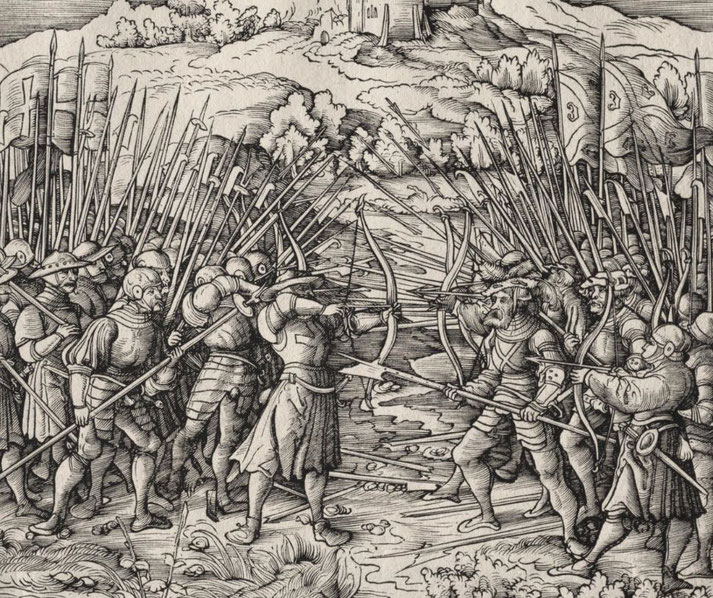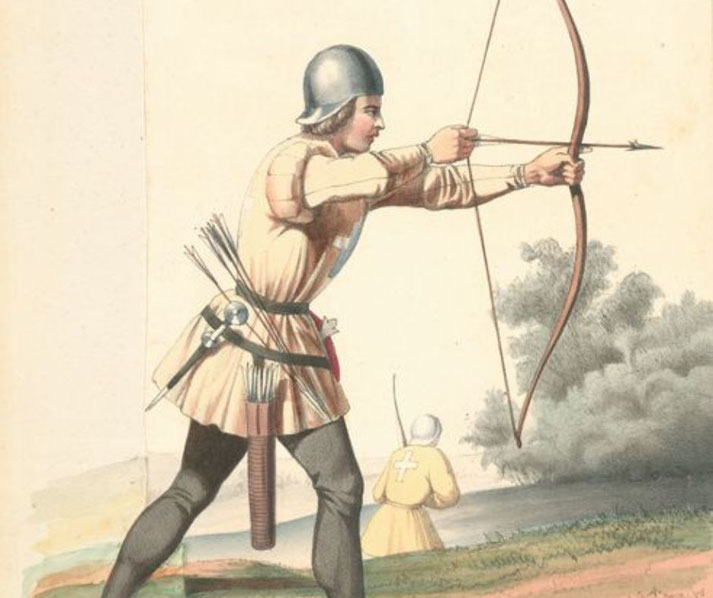The brutal reality of medieval warfare: A glimpse into the chaos of a Middle Ages battle

The clashing of steel, the thunderous roars of men, and the deafening cries of warhorses fill the air. The ground is muddy, slippery with rain and blood, as soldiers in chainmail and plate armor engage in brutal hand-to-hand combat.
Welcome to the battlefield of medieval Europe—a place where chivalry meets savagery, and life can be snuffed out in an instant.
Kinds of warriors in the Middle Ages
On any given medieval battlefield, there were a number of different kinds of warriors.
Kings and generals tried to have a variety of people with a range of different skills that they could use to win any potential fight.
Here are the most common types:
Knights
In the complex tapestry of medieval warfare, knights were often the most visible and celebrated figures.
Clad in heavy plate armor and astride warhorses, these elite warriors were usually of noble birth and trained from a young age in both the arts of war and the codes of chivalry.
They led charges, engaged in single combat with enemy knights, and were instrumental in breaking enemy lines.

Men-at-arms
The knight's role was complemented by men-at-arms, who were professional soldiers serving a lord or king.
Well-trained and equipped with quality armor and weapons, men-at-arms formed the backbone of the infantry, holding the line in battle and engaging in hand-to-hand combat.
Archers
While knights and men-at-arms were often at the forefront, archers provided crucial support from a distance.
Specialized in the use of various bows—longbows, crossbows, or shortbows depending on the region—archers were usually positioned behind the infantry or on elevated ground to maximize their range and effectiveness.
Their arrows could harass and weaken enemy formations or target high-value enemies like knights or commanders.
The role of archers was especially important in countering the heavy cavalry charges led by knights, offering a level of tactical flexibility to medieval armies.

Pikemen
Pikemen, armed with long pikes effective against cavalry, often stood at the front lines.
Their long weapons deterred enemy knights and cavalry from breaking through, providing a first line of defense for the archers and men-at-arms behind them.
Light infantry
Light infantry were less heavily armed and armored than knights and men-at-arms, and performed a variety of roles, from skirmishing and harassing enemy lines to acting as scouts or messengers.
Their agility and speed made them suitable for hit-and-run tactics, and they often filled gaps in the army where needed.
Siege engineers
Siege engineers, though more commonly associated with sieges than open-field battles, had a specialized role in operating heavy machinery like trebuchets and catapults.
These machines could hurl large stones or fireballs, causing massive destruction and chaos among enemy ranks.
Siege engineers were crucial in breaching fortifications and could turn the tide of battle when used effectively.
Peasant soldiers
Peasant soldiers, often referred to as levies, were the untrained masses that frequently made up the bulk of medieval armies.
Unlike knights or men-at-arms, who were professional soldiers with training and quality equipment, peasant soldiers were usually farmers, laborers, or craftsmen conscripted into service.
They were often poorly armed, sometimes with nothing more than farming tools like scythes or pitchforks, and their armor was rudimentary at best, often consisting of padded clothing or leather rather than metal.
Despite their lack of training and equipment, their sheer numbers made them a force to be reckoned with, especially when used effectively in combination with more skilled troops.
However, their inexperience also made them vulnerable, and they suffered high casualties, especially when pitted against well-trained or heavily armored opponents.
Peasant soldiers were the backbone of many medieval armies, providing the manpower that was often crucial for large-scale operations or sieges.
Mercenaries
Finally, mercenaries, soldiers fighting for pay rather than loyalty, added an unpredictable element.
Their skills and equipment varied widely, and they could perform roles similar to men-at-arms or archers, depending on their expertise.
What to expect on the day of battle
Before the battle even begins, preparations are extensive. Soldiers spend days, sometimes weeks, sharpening weapons, repairing armor, and practicing formations.
Archers fletch their arrows, while knights and squires maintain their horses. The air is thick with tension as both sides know that the coming battle could mean life or death, victory or defeat.
As dawn breaks on the day of the battle, both armies line up facing each other, often separated by a field or a hill.
The commanders give rousing speeches, invoking God, king, and country to motivate their troops.
Then, a deafening silence falls over the battlefield, broken only by the distant cries of crows and the rustling of banners in the wind.
The attack
Suddenly, a trumpet sounds, or a commander gives the signal, and the battle begins.
Cavalry charges are often the first to break the silence, their warhorses galloping at full speed towards the enemy lines.
The ground shakes under the weight of the charge, and the first clash is usually devastating, with lances breaking and men falling to the ground, wounded or dead.
After the initial charge, the battle devolves into a chaotic melee. Soldiers engage in brutal hand-to-hand combat, using swords, axes, and maces to break through enemy lines.
Archers release volleys of arrows, aiming to take down as many foes as possible. The noise is overwhelming: the clash of steel, the screams of the wounded, and the battle cries of those still fighting.

How it all ends
As the day wears on, exhaustion sets in. Armor becomes unbearably heavy, weapons feel cumbersome, and the dead and wounded litter the battlefield.
The smell of blood, sweat, and death is overpowering. Many soldiers fight on purely on adrenaline, their bodies pushed past the point of endurance.
When one side finally breaks and retreats, the victors often give chase, aiming to capture or kill as many of the fleeing enemies as possible.
The battlefield is then a grim sight, filled with the dead and dying, the ground muddy and trampled, littered with broken weapons and pieces of armor.
Being in a medieval battle was a brutal, terrifying experience. It was a place where the concepts of honor and chivalry were often overshadowed by the harsh realities of war: death, injury, and the ever-present fear of defeat.
While romanticized in tales and songs, the truth of medieval warfare is far more complex and far less glamorous.
It was a life-altering event that few would ever forget, shaping the course of history one battle at a time.
What do you need help with?
Download ready-to-use digital learning resources
Copyright © History Skills 2014-2025.
Contact via email
With the exception of links to external sites, some historical sources and extracts from specific publications, all content on this website is copyrighted by History Skills. This content may not be copied, republished or redistributed without written permission from the website creator. Please use the Contact page to obtain relevant permission.





